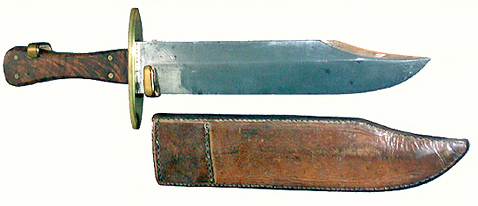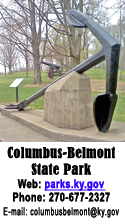|
Bowie Knife
Rezin designed special weapon
and Jim soon made it famous
Kentucky native Jim Bowie was given a special knife in the 1820s by his older brother, Rezin.
Rezin designed it, had it made by a blacksmith and gave it to young Jim as an all-purpose implement. But it was how Jim used it that made the knife an international icon and a popular weapon of choice during the Civil War.
The blade essentially is a large hunting knife and was developed into a device that “… was long enough to use as a sword, sharp enough to use as a razor, wide enough to use as a paddle, and heavy enough to use as a hatchet.” It became a weapon roughly 8-12 inches in length, 1.5-2 inches in width along with a sharp curved point and a sharp edge on the opposite side. A cross guard protected the user’s hand.
 It was on Sept. 19, 1827, that the legend of the Bowie Knife really began. Jim, who was acting as a second in a duel outside of Natchez, Miss., was attacked by others witnessing the duel. He was shot twice and sustained a sword cane wound in the chest, before pulling what was then described as a butcher knife. It was on Sept. 19, 1827, that the legend of the Bowie Knife really began. Jim, who was acting as a second in a duel outside of Natchez, Miss., was attacked by others witnessing the duel. He was shot twice and sustained a sword cane wound in the chest, before pulling what was then described as a butcher knife.
Jim quickly dispatched his assailant with the knife and used it to defend himself against others. Newspapers picked up the story, which became known as the Vidalia Sandbar Fight, and the story spread across the nation.
Two years later, Jim was attacked by three men in Texas who had been hired to kill him. When the fight was over, Jim had used his knife to disembowel one man, virtually decapitate another and split the skull of the third. The hired killers had rifles and Jim was armed only with his knife. The incident cemented the reputation of the Bowie Knife and Jim’s skill as a knife fighter.
His skill and the story of his knife spread to England. Then, everyone wanted a Bowie Knife. When the Civil War began, many soldiers, especially those in the Confederate army, had to provide their own weapons. And the Bowie Knife became a popular part of their armament.
Following the Battle of Perryville in 1862, a Bowie Knife was found on the battlefield and eventually made its way to the Smithsonian Institute in Washington where it continues to be on display. The knife continued to be popular from the 1840s through 1865. It was used by U.S. troops in the Mexican War and on the frontier in Kansas and Missouri in the 1850s.
Jim Bowie’s Kentucky roots stem from March 10, 1796, when he was born in Logan County. Jim was the ninth of 10 children born to Elve Ap-Caesby Jones and John Bowie. Jim’s father was wounded while fighting in the American Revolution, and, in 1782, married the young woman who had nursed him back to health.
The Bowies moved frequently, first settling in Georgia before moving to Kentucky. Eventually, they moved to Missouri and on to Louisiana. Jim and Rezin learned to read, write and speak Spanish and French fluently. Jim also became proficient with pistol, rifle and knife and had a reputation for fearlessness.
As a boy, one of his Indian friends even taught him to rope alligators.
Jim was among those who died at the Alamo in the Texas Revolution in 1836.
|














 It was on Sept. 19, 1827, that the legend of the Bowie Knife really began. Jim, who was acting as a second in a duel outside of Natchez, Miss., was attacked by others witnessing the duel. He was shot twice and sustained a sword cane wound in the chest, before pulling what was then described as a butcher knife.
It was on Sept. 19, 1827, that the legend of the Bowie Knife really began. Jim, who was acting as a second in a duel outside of Natchez, Miss., was attacked by others witnessing the duel. He was shot twice and sustained a sword cane wound in the chest, before pulling what was then described as a butcher knife.